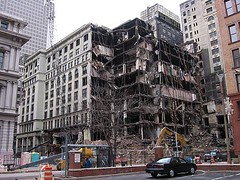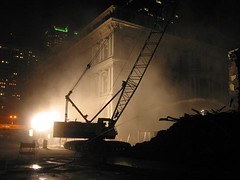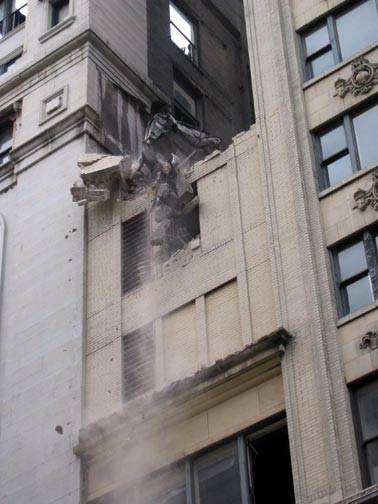Historic Preservation: Profession or Calling
 All photos by Alan Brunettin from the Save the Century website.
All photos by Alan Brunettin from the Save the Century website.Today's New York Times has an article, "When Preservation Means Demolition" about the demolition of the Century Building in St. Louis, and the involvement of the National Trust for Historic Preservation in the building's demise.
"But after 15 years of fighting by local preservationists it was razed in February to make way for a garage. The battle for the Century, with its familiar plot and cast of characters - preservationists squaring off against developers and politicians - resembled a typical preservation dispute. Yet it had an unusual twist: for the first time anyone involved can remember, the National Trust for Historic Preservation, the country's most powerful preservation group, sided with the wreckers. In fact the redevelopment project that led to the Century's demise was financed with the National Trust's help.
Although the circumstances surrounding the Century are unusual, critics say the national trust, a private nonprofit organization with more than 200,000 members, has set a dangerous precedent."
I first learned of the case almost two years ago, from an article the St. Louis Business Journal. (Also see Closing the deal: Six-year struggle comes to an end and $43 million suit threatens Old Post Office: Class-action suit targets Century preservation.)
The article covers the issue reasonably well, but didn't seem to acknowledge the depth and resilience of the advocacy campaign to save the building--"Save the Century."
The reason the Century Building is being demolished is for a parking garage. The Save the Century campaign documented parking use in area structures and discovered a plethora of parking spaces, far beyond the capacity required to service the new development. So the article really does everybody a disservice by not getting into more detail about this issue.
 "Beauty and the Beast"
"Beauty and the Beast"(There need to be more ways for advocates to get together at the Trust meetings. I am glad that I was able to finally meet Matt, as well as some great Louisville advocates who had heartbreaking stories of their own. The issue of saving great buildings, great assets that are the foundation of urban revitalization, in the face of more traditional and wrong-headed "economic development" strategies is no less relevant today than it was during the time of urban renewal. As I say time and time again, the only sustainable urban revitalization strategies that work long term are based on historic preservation.)
The headline of this entry comes from my experience of working on these issues in the city, and interacting with preservation professionals who to my way of thinking, believe that because "we have so many historic buildings as it is, what's the problem with losing one more?" while preservation advocates try, "by any means necessary" to save exemplary buildings, because we believe that these majestic and vernacular buildings are irreplaceable and key to the beauty, livability, history, and grandeur in our lives. Like the loss of the Poletown neighborhood in Detroit for a parking lot, planning for the automobile has many pernicious effects. Losing one more great building for a parking garage in St. Louis is but another.
In any event, after awhile, losing "a building here and a building there" soon adds up to blocks and blocks of demolished buildings. It is the cumulative impact that needs to be considered, not buildings one by one.

Ironically, yesterday's New York Times has an article about the resurgence of Downtown St. Louis, "In the Arch's Shadow, Signs of Revival". I agree with the characterization of the downtown as a ghost town. I was there for a conference in the late 1990s and it was barren, with great buildings, but you had to drive miles out of the city center to find a drug store. The later merger of the main local bank into what is now Bank of America didn't help. Neither will the merger of May Department Stores into Federated. Fewer workers in the core make it harder to rebuild the core. We are fortunate in DC to have the federal government which despite who's in office, the government continues to expand inexorably (although this puts pressure on our historic building stock as well).
Still, St. Louis has some great things going on. Matt Ghio is also involved in a young creative class urban promotion group called Metropolis St. Louis. And the Downtown St. Louis Partnership has a great promotional-advertising campaign called Talk About Downtown.
In fact, I shamelessly borrowed and adapted this campaign into the "Talk About H Street" image development-advertising campaign for H Street Main Street. Kevin Palmer developed the creative and the ads (thank you again Kevin). The ads ran in the Voice of the Hill every other month when I was the chair of the Promotions Committee for the program.



0 Comments:
Post a Comment
<< Home